New End Hospital
New End, Hampstead, NW3 1JB
Medical dates:
Medical character:
1870 - 1986
Acute. Later, geriatric
The Hampstead Union
workhouse, with accommodation for 200, was founded in 1800 for the
unemployed, the destitute, and unmarried mothers and their
children. It also contained a casual ward for the homeless.
It was replaced in 1842 by the Edmonton workhouse, but this soon proved
inadequate and the Hampstead workhouse was rebuilt in 1847 and reopened
in 1848. A 4-storey infirmary block was added in 1869. It had
tall windows (a bed was placed between each one) which provided
cross-ventilation and ample light. In 1878 the infirmary was extended
to the south. Most of the wards contained 30 beds with two small side
wards.
In 1883, due to the need for more patient accommodation, a new circular ward block was built to the west of the infirmary building, at a cost of £12,000. The new block opened in 1884. It had 3 floors containing wards, with accommodation for the nursing staff on the top floor. Above them was a 12,000 gallon water tank. Each ward was 50 ft (15.3 metres) in diameter and contained 24 beds arranged radially, with the head of the bed against the wall.
In 1896 another 4-storey
infirmary block was built on the corner of New End and Heath Street.
From 1915 the workhouse and its infirmary were used as a military hospital during WW1 for soldiers who were wounded or shell-shocked. The facilities were improved, with X-ray apparatus and an operating theatre being installed. Surgical cases did well because of the elevation of the ground (it was believed that wounds healed much more quickly the higher the altitude and the purer the air). The dome of St Paul's Cathedral could be seen from the Infirmary buildings, as they were both at the same altitude.
In 1922 the buildings were handed back to the Hampstead Guardians and modernised. The Infirmary was renamed the New End Hospital. The wards were painted in a pale green and cream colour. Wireless was installed in all the wards.
In 1928 men were
accepted for nursing training, but were exempted from attending
gynaecology lectures.
In 1930 the site was taken over by the LCC and became a general hospital with 260 beds, including 26 for children. Because of the need, a maternity department opened with 19 beds. One of the maternity wards was maintained by the Borough Council but staffed by the Hospital. The old workhouse buildings provided staff accommodation and offices. The Hospital also had an Out-patients Department and a Casualty Department.
In 1931 a Thyroid Clinic was initiated by the surgeon Sir Thomas Dunhill, which gained an international reputation for the treatment of patients suffering from toxic goitre and myasthenia gravis. In 1942 the first thymectomy in the United Kingdom was performed at the Hospital.
The Hospital joined the NHS in 1948 under the control of the Archway Group Hospital Management Committee, part of the North East Metropolitan Regional Hospital Board. It had 221 beds. The X-ray and Physiotherapy Departments were enlarged. It became recognised as a hospital for acutely sick patients and was especially renowned as a centre for endocrinology. By 1955 the world's most modern radioactive iodine isotope had been developed in the basement.
In 1961 the weekly cost of an in-patient was
£28 5s 8d £28.28), compared to the previous year when it
was £26 9s 9d (£26.49).
In 1968 the Hospital joined the Royal Free Hospital Group but, when the new Royal Free Hospital opened in 1972, acute services gradually moved there and the New End Hospital eventually became a geriatric hospital.
In 1974, following a major reorganisation of the NHS, the Hospital came under the administration of the North Camden (Teaching) District Health Authority, part of the North East Thames Regional Health Authority. In 1978 the Hospital had 143 beds.
In 1982, after another NHS reorganisation, the
Hospital came under the control of the Hampstead District Health
Authority. It had 127 beds.
Plans to close the Hospital became a reality in 1986, despite much
opposition. Profits from the sale of the site were used to fund
the redevelopment of Queen Mary's
House, Hampstead, as a geriatric wing of the Royal Free Hospital.
|
Present status
(December 2007) The mortuary across the road became the New End Theatre in 1974. Update: January 2012 The New End Theatre closed in August 2011. The building is now The Village Shul. |
|---|
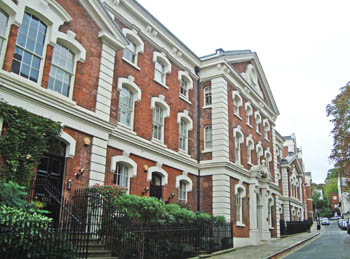
The vestry building for the workhouse, built in 1878, was known as Kendall Hall after its architect, H.E. Kendall.
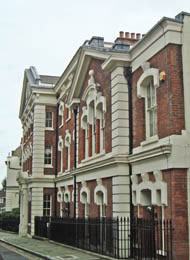
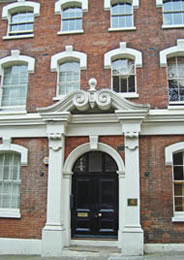
The Grade II listed building is now an apartment block.
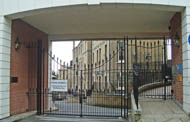
The view of the ward blocks through the gate, looking into the courtyard.
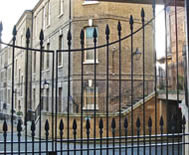
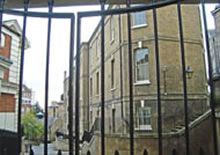
One of the old ward
blocks of the Hampstead Infirmary, built in 1869.
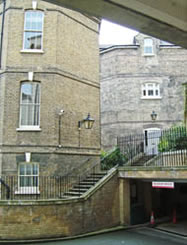
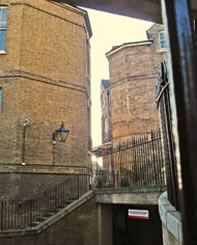
Demand for more hospital accommodation led to another ward block being built in 1883-1884 - the circular ward block, just visible through the gate. It was the first free-standing example of a circular 'ward tower' in the country. The building is now Grade II* listed.
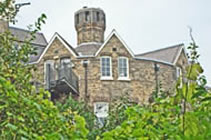
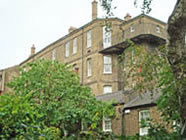
The top of the circular ward block and water tank tower (left). The former ward blocks as seen from the south from Streatley Place (right).
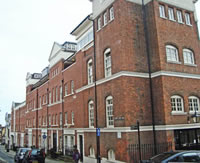
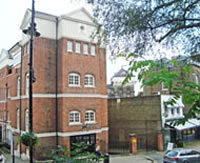
In 1896 another block was added at the corner of New End and Heath Street.
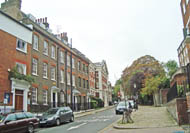
The former Hospital, as seen from Well Road
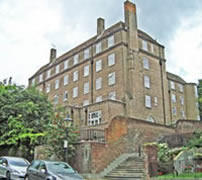
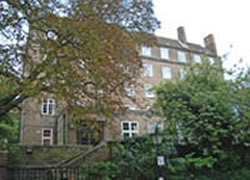
The Nurses' Home was built in the early 1950s. Controversial plans were submitted in November 2011 to demolish the building and build an apartment block with a 3-storey basement in its place. They have since been withdrawn (December 2011).
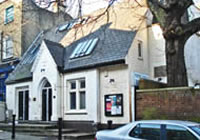
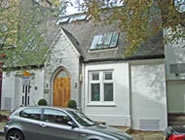
Built in 1890 on the opposite side New End, the mortuary was connected to the hospital by a tunnel, enabling bodies to be transported discreetly under the road. In 1974 the building became the New End Theatre (left - photographed in December 2007).
Update: January 2012
The theatre closed in August 2011 and the building is now a Jewish arts centre and a synagogue, The Village Shul (right - photographed in December 2011).
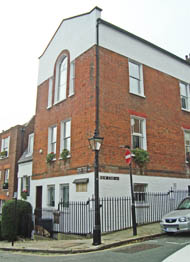
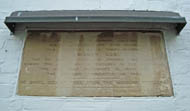
The old Provident Dispensary on the corner, to the south of the former Hospital, was built in 1850 following a cholera epidemic the previous year (left). The stone plaque on its eastern side dedicates the dispensary and soup kitchen as thanks to Almighty God for deliverance from cholera.
References (Accessed 8th June 2019)
(Author unstated) 1898 Reflections from a Board Room Mirror. The Nursing Record and Hospital World, 3rd September, 194.
(Author unstated) 1928 The New End Hospital, Hampstead. British Journal of Nursing (October), 271-272.
Taylor J 1988 Circular hospital wards: Professor John Marshall's concept and its exploration by the architectural profession in the 1880s. Medical History 32, 426-448.
http://burghhouse.museumsites.com
https://wellcomecollection.org
www.britishlistedbuildings.co.uk (1)
www.britishlistedbuildings.co.uk (2)
www.flickr.com (1)
www.flickr.com (2)